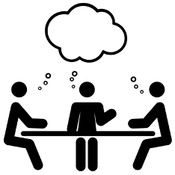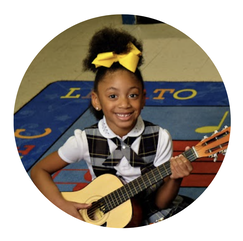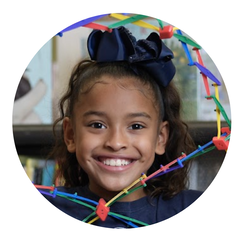Personalized Learning (PL) is a one-size-fits-one approach to instruction that (1) taps into each student's strengths, needs, and interests to customize learning and (2) supports student voice and choice in what, how, when, and where they learn to ensure that all students achieve at their greatest potential. It requires the parent, the teacher, and most importantly the student, to partner in their education.
In order to ensure our learners are future-ready, we must provide them with the necessary knowledge and skills to thrive in a different world than the one we grew up in. Personalized Learning provides educators with the strategies to meet individual needs and provide authentic learning opportunities that emulate what it might look like to apply learning in a future career or situation.
In order to ensure our learners are future-ready, we must provide them with the necessary knowledge and skills to thrive in a different world than the one we grew up in. Personalized Learning provides educators with the strategies to meet individual needs and provide authentic learning opportunities that emulate what it might look like to apply learning in a future career or situation.
Role of the Student, Teacher, and
Family in a Personalized Learning Environment
Role of the Student
|
Actively engage in her learning and make connections to prior knowledge.
|
Set goals, track his own progress and persist in achieving them.
|
Collaborate with peers and teachers to maximize her learning experiences.
|
Advocate for himself by asking questions and looking for resources that further his learning.
|
Role of the Teacher
|
Develop a student- centered learning environment that adapts to students’ strengths, motivations, interests, and needs.
|
Design learning experiences that facilitate critical thinking and make connections that produce real world application.
|
Make communication and collaboration a regular part of the learning environment.
|
Develop a classroom culture that fosters creativity and values the talents of each student.
|
Advocate for student needs and work with support staff to meet those needs.
|
Role of the Family/ Caregiver
|
Be an informed advocate for your child’s learning. Share information with teachers, mentors, and providers involved in your child’s learning.
|
Be Intentional about cultivating mindsets and habits that support lifelong learning. Promote ownership and involve your child in opportunities to learn and demonstrate learning.
|
Get Involved! Learn alongside your child and promote student-centered learning by exploring options for how, where, and when your child learns.
|
Inspire your child to try, persist, and progress. Model as you watch, listen, empathize, connect, and activate.
|
This section is adapted from:
Friend, B., Patrick, S., Schneider, C., & Vander Ark, T. (2017). What’s Possible with Personalized Learning? Vienna, VA: International Association for K-12 Online Learning (iNACOL).
Friend, B., Patrick, S., Schneider, C., & Vander Ark, T. (2017). What’s Possible with Personalized Learning? Vienna, VA: International Association for K-12 Online Learning (iNACOL).
How Personalized Learning is Different
Integrate Positive Youth DevelopmentCaring, consistent student-adult relationships that communicate high expectations for student learning and behavior
Clear expectations for student competencies and standards of performance Opportunities for students to contribute to the school environment and have a voice in decisions Encouragement of student responsibility for meeting learning and personal goals Openness to and encouragement of family participation Integration of community participation, assets and culture |
Prioritize Mastery of Rigorous Standards Aligned to College + Career ReadinessCurriculum that enables all students to meet rigorous standards
Multiple opportunities for students to show mastery through performance-based assessments Student advancement based on demonstration of mastery of knowledge and skills |
Personalize Student Learning to Meet Student NeedsInstruction in a variety of learning modalities, linked to students’ strengths and learning goals
Data-driven, real-time feedback for students and teachers Embedded, performance-based formative assessments Effective use of technology for anytime, anywhere learning |
Empower and Support StudentsLinks between future academic and career paths and current learning
Transparency about where students stand on their academic progress |
This section is taken directly from:
Friend, B., Patrick, S., Schneider, C., & Vander Ark, T. (2017). What’s Possible with Personalized Learning? Vienna, VA: International Association for K-12 Online Learning (iNACOL).
Friend, B., Patrick, S., Schneider, C., & Vander Ark, T. (2017). What’s Possible with Personalized Learning? Vienna, VA: International Association for K-12 Online Learning (iNACOL).
ISTE Standards for Students
|
Personalized Learning aims to create learner-centered environments that embrace opportunities that encourage student agency and future-ready learning.
This section highlights the International Society for Technology in Education (ISTE)'s standards for students. Use the videos below to see what student learning might look like in a Personalized Learning environment. |
Empowered Learner
I use technology to set goals, word toward achieving them and demonstrate my learning.
I use technology to set goals, word toward achieving them and demonstrate my learning.
|
|
|
|
|
Digital Citizen
I understand the rights, responsibilities, and opportunities of living, learning, and working in an interconnected digital world.
I understand the rights, responsibilities, and opportunities of living, learning, and working in an interconnected digital world.
|
|
|
|
|
Global Collaborator
I strive to broaden my perspective, understand others and work effectively in teams using digital tools.
I strive to broaden my perspective, understand others and work effectively in teams using digital tools.
|
|
|
|
|
Creative Communicator
I communicate effectively and express myself creatively using different tools, styles, formats, and digital media.
I communicate effectively and express myself creatively using different tools, styles, formats, and digital media.
|
|
|
|
|
Knowledge Constructor
I critically select, evaluate, and synthesize digital resources into a collect that reflects my learning and builds my knowledge.
I critically select, evaluate, and synthesize digital resources into a collect that reflects my learning and builds my knowledge.
|
|
|
|
|
Computational Thinker
I identify authentic problems, work with data and use a step-by-step process to automate solutions.
I identify authentic problems, work with data and use a step-by-step process to automate solutions.
|
|
|
|
|
Innovative Designer
I solve problems by creating new and imaginative solutions using a variety of digital tools.
I solve problems by creating new and imaginative solutions using a variety of digital tools.
|
|
|
|
|
This section highlights the International Society for Technology in Education (ISTE)'s standards for students.
ISTE. (n.d.). https://www.iste.org/standards/iste-standards-for-students
ISTE. (n.d.). https://www.iste.org/standards/iste-standards-for-students

















